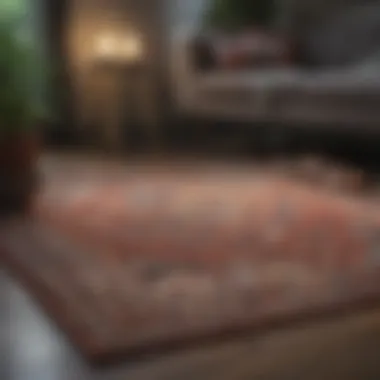Discovering Top Quality Rug Stores: A Smart Guide


Intro
Choosing the right rug can significantly influence the aesthetics and function of your home. With a myriad of options available, it is essential to understand what defines a quality rug store. This guide delves into several critical elements such as design inspirations, maintenance tips, and purchasing strategies. Our objective is to equip homeowners, interior design enthusiasts, and gardening aficionados with knowledge pivotal for informed decisions in selecting rugs that complement their spaces.
Design Inspirations
In any interior space, rugs play a crucial role in enhancing the overall design. As such, understanding current design trends will aid you in selecting a rug that seamlessly integrates with your home’s decor.
Trending Styles
Rug styles have evolved greatly in recent years. Notable trends include:
- Minimalist Designs: Characterized by clean lines and simple patterns, they bring elegance without overwhelming the space.
- Bohemian Vibes: Rich in color and texture, boho rugs often feature layered patterns, creating a cozy atmosphere.
- Geometric Patterns: These rugs are highly popular, providing a modern touch and eye-catching appeal.
- Vintage and Antique: Such rugs add character, often telling a story while showcasing age-old craftsmanship.
Color Palettes
Rug color can dramatically alter a room’s mood. Some guiding principles for selecting colors include:
- Consider the existing color scheme of your room. Choose a rug that either complements or contrasts it effectively.
- Neutral tones can unify various elements. They provide a backdrop for other decor to shine.
- Bold colors create focal points, drawing the eye and igniting conversation.
Maintenance and Upkeep
A quality rug can last a lifetime with proper care. Understanding maintenance techniques is essential to prolong its life and maintain its appearance.
Seasonal Maintenance Checklist
A seasonal maintenance routine can enhance longevity. Key tasks may include:
- Spring Cleaning: Rotate the rug to ensure even wear and vacuum thoroughly to remove dirt.
- Summer Care: Be mindful of direct sunlight. Consider using UV protectant sprays.
- Fall Preparation: Check for any damage from summer activities. Repair small issues before they become larger problems.
- Winter Vigilance: Keep rugs dry. Use a damp cloth to immediately blot any spills.
Cleaning and Organization Tips
Rugs should be cleaned regularly to preserve their appearance. Best practices include:
- For small stains, use a mild soap solution and a soft cloth.
- Set a cleaning schedule; regular vacuuming prevents dust accumulation.
- When needed, consult professional cleaning services, especially for larger or antique rugs.
"Investing time in maintaining your rug will extend its life and ensure it remains a centerpiece in your home."
In the realm of quality rug stores, understanding these aspects allows you to make well-informed decisions when purchasing. Whether seeking unique designs or practical maintenance tips, this guide is tailored to enhance your shopping experience.
Prolusion to Rug Shopping
Rug shopping is more than just a task; it embodies the intersection of aesthetics and functionality in interior design. Rugs serve an instrumental role, providing warmth, texture, and color to any space. This section lays the groundwork for understanding why choosing the right rug and store is critical for enhancing your home's environment.
Understanding the Role of Rugs in Interior Design
Rugs can transform a room with their presence. They act not only as decorative pieces but also as practical elements that define areas, add comfort, and unify décor. A well-chosen rug can accentuate furniture placements and soften hard surfaces, providing visual relief. The material, color, and design of a rug play substantial roles in communicating style and personality.
Moreover, rugs have a unique capability to influence the mood of a space. For instance, a large, bright-colored area rug can energize a living room, while a muted, natural fiber rug creates a sense of calm in a bedroom. Thus, understanding the role of rugs is pivotal when deciding how they fit into your overall interior design strategy.
Significance of Selecting the Right Store
Choosing the right store is as important as selecting the rug itself. Not all rug stores offer the same level of quality, knowledge, or selection. A reputable store can provide invaluable guidance on materials, design trends, and care instructions, ensuring that your buying experience is informed and satisfactory.
Purchasing rugs from a quality store often ensures access to a diverse range of products, including unique or handmade options that you might not find elsewhere. These stores typically employ knowledgeable staff who can help clarify the differences between various types of rugs, making the purchase process smoother. Furthermore, supporting quality rug stores, particularly local ones, fosters community growth and sustainability.


Factors to Consider When Choosing a Rug Store
Selecting a rug store is not a trivial task. The quality of a store can significantly affect the overall satisfaction of your rug shopping experience. Many factors come into play when choosing the right rug store, including the store's reputation, the variety of products offered, and the pricing structures involved. Each of these elements contributes to ensuring that the consumer finds the ideal rug while receiving good value for their money. A thoughtful approach can lead to more informed decisions, ultimately enhancing your living space.
Reputation and Customer Reviews
The first aspect to consider is the reputation of the rug store. A store with a solid reputation often indicates reliable service and quality products. Checking customer reviews can provide invaluable insights. Look for patterns in feedback, as repeated positive comments about specific qualities, such as customer service or product quality, can suggest consistency in those areas.
"A store’s reputation is often its most valuable asset. Consumers can gauge their potential experiences by reading others' narratives."
Moreover, word-of-mouth recommendations from friends or family can also give guidance regarding reliable providers. Investigate both online and offline platforms for comprehensive reviews, including sites like Reddit or Facebook, where users share their experiences.
Product Range and Quality
As a prospective buyer, you should also evaluate the range and quality of rugs available at a store. A diverse product range may indicate a commitment to meet various tastes and preferences. This includes traditional options like Oriental and Persian rugs, as well as contemporary styles that may appeal to a modern aesthetic.
In addition to variety, the quality of rugs is paramount. Pay attention to the construction materials; higher quality fibers like wool and silk often translate to durability and luxury. Inspecting samples in-store can provide a tactile sense of quality that photos online often fail to convey. Evaluating product proudly displayed can also give hints about the overall standards upheld by the store.
Pricing and Value for Money
Pricing is another critical factor when selecting a rug store. High prices are not always indicative of high quality. Understanding the range of market prices can help you identify what constitutes reasonable value for money. Look for stores that provide transparency in pricing, ensuring that you know what you are paying for and why.
Remember, sometimes, investing a little more upfront can lead to savings in the long run due to durability and timeless style. Comparing prices across multiple stores can also provide additional insights into industry standards. Consistent pricing that aligns with the quality advertised is a good sign of a reputable store.
Types of Rugs Offered by Stores
Understanding the types of rugs available in stores is essential for any consumer seeking to enhance their home or office space. Different types of rugs carry specific attributes and aesthetics. Each category also has its own merits, influencing both the physical environment and the emotional ambiance of a room. When consumers know the variety, they make better choices that align with design goals and practical needs.
Oriental and Persian Rugs
Oriental and Persian rugs are often synonymous with traditional craftsmanship and rich cultural heritage. These rugs are usually handwoven using high-quality materials such as silk or wool, resulting in intricate patterns, vibrant colors, and durability. The history of these rugs dates back centuries, which makes them significant not only as decorative items but also as artworks. Their value often appreciates over time due to their craftsmanship, rarity, and historical context.
Factors to consider:
- Authenticity: When shopping, always ask for proof of authenticity. This gives assurance that you are investing in a true piece.
- Size and Placement: Due to their ornate designs, placement is key to ensure they do not overwhelm a space.
- Maintenance Needs: These rugs require special care, including periodic professional cleaning.
Contemporary and Modern Rugs
Contemporary and modern rugs often embody minimalism and innovation, aimed at complementing various interior design styles. They can be crafted from synthetic materials or natural fibers and often feature bold geometric patterns or unique colors. These rugs serve as focal points in modern décor and can add a touch of sophistication to any room.
Important considerations include:
- Versatility: Suitable for multiple settings, making them adaptable to evolving design trends.
- Durability: Many modern rugs are designed to withstand heavy traffic, which is ideal for active households.
- Affordability: Generally more affordable than antique rugs, they provide excellent options for individuals on a budget.
Natural Fiber Rugs
Natural fiber rugs are crafted from sustainable materials such as jute, sisal, or wool. These rugs are valued for their eco-friendliness and organic look, which brings a sense of warmth and texture to interiors. They are inherently durable and can seamlessly integrate into various design styles from rustic to contemporary.
Some benefits include:
- Breathability: Natural fibers allow for air circulation, promoting a healthier atmosphere.
- Non-Toxic: Free from harmful chemicals, these rugs are suitable for homes with pets or young children.
- Easy Maintenance: Most natural fiber rugs are easy to clean, requiring just a simple vacuum or shake outdoors.
Indoor/Outdoor Rugs
Indoor/outdoor rugs are multi-functional items designed to withstand exposure to the elements while providing aesthetic appeal. They are commonly made from synthetic materials that resist fading and moisture. This versatility makes them ideal for patios, balconies, and high-traffic areas within the home.


Key factors include:
- Resilience: Engineered to endure weather variations and stains, which adds to their longevity.
- Easy to Clean: Many can simply be hosed down to remove dirt and spills, making them practical for outdoor use.
- Design Variability: Available in various patterns and colors, allowing homeowners to maintain cohesive decor indoors and out.
"Knowledge of rug types is not only helpful for aesthetic appeal but also essential for functionality and longevity in design choices."
Exploring the breadth of rug options available in stores empowers consumers, allowing them to select the right type for their aesthetic and practical needs. These considerations ultimately enhance the buying experience, leading to satisfied and informed purchases.
Shopping Online vs. In-Store
Shopping for rugs brings a significant decision for consumers: whether to shop online or to visit a physical store. Each option holds distinct advantages and disadvantages that can affect the overall experience and satisfaction. This section will delve into the crucial elements surrounding both shopping modalities, emphasizing both online and in-store benefits as well as considerations that can help customers make well-informed decisions.
Advantages of Online Shopping
Shopping online has reshaped the experience of rug buying, making it accessible to a wider audience. Some notable advantages include:
- Convenience: Online shopping allows for browsing at any time. Consumers can avoid the hassles of traffic, parking, and crowds, making the process more enjoyable.
- Wider Selection: Numerous online retailers boast extensive inventories. From traditional styles to modern interpretations, customers have a broader range to choose from.
- Comparative Shopping: It is easy to compare prices and styles across different sites. Bookmarking options and checking back can reveal deals that may not be immediately available in physical stores.
- Customer Reviews: Online stores often feature customer reviews and ratings, providing insights into product quality and retailer reliability. This feedback allows buyers to make informed choices.
Benefits of Visiting Physical Stores
While online shopping has distinct advantages, visiting physical stores also presents valuable benefits:
- Tactile Experience: Being able to feel the texture of a rug and see its colors in person can inform buying decisions. Customers can assess quality and how a rug will fit into their space visually.
- Personal Interaction: Shopping in-store allows customers to interact directly with staff. Store associates can provide valuable recommendations and insights based on experience and expertise.
- Immediate Availability: Buyers can take their chosen rugs home immediately. This is particularly useful when quick decisions are needed, such as for event hosting or short-term usage.
- Local Support: Purchasing from physical stores, especially local businesses, contributes positively to local economies and sustains jobs within communities.
Comparative Analysis of Experiences
When weighing online versus in-store shopping, each option offers unique experiences that can greatly impact customer satisfaction:
- Time Investment: Online shopping can save time compared to driving to multiple stores. However, it can elongate the overall process due to waiting for shipping.
- Return Policies: While many online retailers provide lenient return policies, customers may find in-store returns simpler and more immediate, avoiding potential shipping costs or delays.
- Visual Understanding: Although product images online may be high quality, they can still differ from reality. In-store shopping ensures a more genuine understanding of how a rug's colors and textures appear in real life.
Supporting Local Rug Businesses
Supporting local rug businesses is essential for numerous reasons that extend beyond just purchasing a rug. This section delves into the benefits of engaging with local stores and the positive impact on the community.
Importance of Local Economy
Buying from local rug businesses strengthens the local economy. When consumers spend money in their communities, it circulates and contributes to the growth of local jobs. Local businesses are often more responsive to consumer needs and changes in the market. They provide unique employment opportunities that can lead to career growth within the community.
Local rug stores also tend to stock items that reflect the culture and aesthetics of the area, fostering a vibrant local identity. This can lead to a rich tapestry of offerings that larger, national retailers may lack. More importantly, patronizing these businesses enables the community to become more resilient against economic downturns. Local shops contribute taxes that support community services such as schools and infrastructure.
Unique Offerings in Local Stores
Local rug shops frequently offer distinct selections that large retailers do not. Many of these stores curate their collections from local artists or artisans. This not only supports creativity but also encourages sustainable practices.
- Custom Options: Local shops often provide customization services for rugs, allowing for adjustments in size, color, and design.
- Handcrafted Quality: Rug enthusiasts may find unique, handcrafted rugs that are not mass-produced, thus ensuring superior craftsmanship.
- Knowledgeable Staff: Personnel in local stores usually have specialized knowledge about rugs and can provide personalized guidance, helping customers make informed choices.
In summary, buying from local rug businesses offers diverse products tailored to individual needs while contributing positively to the local economy. By investing in these shops, consumers help cultivate a vibrant community rich with options and opportunities.
Rug Maintenance and Care
Maintaining a rug is not only about aesthetics; it plays a crucial role in longevity and durability. Rugs, whether they are intricate Persian designs or simple contemporary styles, require intentional care. Proper maintenance ensures that the colors remain vibrant and the textures do not fade or deteriorate over time. Understanding and implementing maintenance practices can save homeowners from costly replacements and extensive repairs.
Regular Cleaning Practices
Routine cleaning is essential for preserving the appearance of a rug. The method of cleaning can depend on the material and weave. For most rugs, simple vacuuming is a good start. It is important to use a vacuum with a suction-only mechanism, avoiding beater bars that can damage fibers. Vacuuming once a week helps remove dirt and dust embedded in the fibers.


In cases of spills, immediate action is crucial. Blotting the spill with a clean, dry cloth can prevent stains from setting in. Avoid rubbing, as this can spread the liquid further. Following up with a mild detergent can assist in cleaning the area more thoroughly. For more sensitive rugs, consulting care instructions or a professional cleaner can be beneficial. Regular professional cleanings, perhaps every one to three years, are also recommended for deeper cleaning beyond regular maintenance.
Preventing Damage to Rugs
Preventative measures can significantly extend the life of a rug. Protecting rugs from direct sunlight can avoid fading. Using curtains or blinds can be an effective way to limit exposure. Employing rug pads adds a layer of protection against wear and provides cushioning. This is particularly important in high-traffic areas, where friction can wear down the fibers.
Another consideration is the placement of rugs in relation to furniture. Heavy furniture can compress fibers, leading to permanent damage. Regularly moving furniture slightly can redistribute pressure on the rug. Additionally, ensure that pets are well-trained to avoid accidents that could lead to stains or odors.
Repairing and Restoring Rugs
Despite best efforts, repairs may become necessary. Over time, rugs can show signs of wear, fraying, or tearing. It is important to address these issues promptly. For minor repairs, such as fraying edges, using a needle and thread can sometimes suffice. Matching the thread color with the rug is crucial for aesthetics.
In more severe cases, a professional restoration service is usually the best option. Experts can reweave and patch areas properly, helping to maintain the rug’s visual integrity. Restoration services can address problems such as moth damage or water stains effectively.
Remember, investing time in regular maintenance, damage prevention, and appropriate repair can turn a rug from just another floor covering into a cherished piece of art that enhances the beauty of a home.
Consumer Insights and Experiences
Understanding consumer insights and experiences offers a unique lens through which we can view the complexities of rug shopping. For many, acquiring a rug goes beyond mere aesthetics; it taps into emotional and practical realms. Many buyers share a strong connection to their living spaces, intending to create environments that resonate with comfort and style. Thus, the experiences of other consumers provide invaluable information, helping potential buyers navigate their choices more effectively.
Insights from real consumers highlight important factors like the importance of quality and the variety of options available. Those who have embarked on rug purchases can testify about their journeys, which often include considerations far beyond price alone. Their first-hand accounts reveal how various factors, including the purchasing process, quality of products, and customer service at stores, shape their experiences.
Gaining knowledge from these experiences arms buyers with information that can prevent common pitfalls encountered during shopping. Additionally, it can shift perceptions of what to prioritize when visiting different rug stores. For instance, stories of past purchases illustrate preferences in fabric types, color schemes, and design choices that might not be immediately apparent to a first-time buyer.
"Insights from past buyers can guide new customers on what to expect and what to watch out for in rug stores."
Conversing with fellow consumers also aids in identifying potential challenges that can surface during the buying process. Learning about others’ experiences builds confidence and narrows down potential options, leading to informed decisions when selecting both the rug and the store.
Stories of Successful Purchases
Every successful purchase story serves as a guide for others. Consumers who have discovered the right rug often recount moments of joy and satisfaction as they transformed their spaces. Many emphasize the feeling of luxury and elegance brought forth by an exceptional rug. Successful buyers usually note the significance of research and preparation before stepping into stores.
For example, Jane, a homeowner in New York, shared her experience of selecting a Persian rug. After thorough research about different styles, she visited a local store that specialized in imported rugs. The staff was knowledgeable and guided her based on her intended room and decor. She walked away, not just with a rug but a piece that ties her space together beautifully.
Similarly, another consumer, Michael, highlighted the online shopping experience. He narrated how he carefully followed online reviews before deciding on a unique indoor/outdoor rug that looked equally striking in his living room and on his patio. His experience encapsulated the advantages of extensive consumer insights available online, reinforcing the notion that well-informed decisions lead to satisfaction.
Common Challenges Faced by Consumers
Purchasing a rug can be fraught with several challenges that consumers often encounter. One significant issue is the overwhelming number of options available. Prospective buyers may feel confused when faced with a myriad of styles, materials, and prices. Without a clear understanding of what to look for, consumers often find themselves indecisive.
Another challenge is the inconsistency in quality. Many consumers reported their disappointment after purchasing rugs that did not meet their expectations in terms of durability and aesthetics. Knowing how to spot high-quality rugs is paramount, and many successful buyers emphasize the importance of asking questions and seeking recommendations.
Lastly, navigating returns and exchanges can also become a hurdle. As most people desire to be satisfied with their purchase, understanding store policies can be a potential stumbling block. It is advisable for consumers to inquire about these policies before finalizing their transactions.
By addressing these common challenges and sharing experiences, potential rug buyers become better equipped to make informed decisions, avoiding the pitfalls that others have encountered.
End
The conclusion of this article serves as a vital summarization and reflection on the multifaceted journey through selecting quality rug stores. This guide has navigated several crucial elements, empowering consumers to make informed decisions about their rug purchases. In a world filled with options, understanding the significance of quality, design, and place of purchase cannot be overstated. The last insights derived from the engaging content aim to reinforce the knowledge gained throughout this comprehensive examination.
Recap of Key Points
Among the most important aspects discussed in this article are:
- Understanding the Role of Rugs: Rugs are not merely decorative; they enhance the aesthetic appeal and functionality of a space.
- Selecting the Right Store: A reputable store ensures quality and provides a wider range of options tailored to consumers’ needs.
- Factors in Choosing a Store: Key factors such as reputation, product range, pricing, and value must be carefully evaluated to ensure a satisfying shopping experience.
- Types of Rugs: Familiarizing oneself with the various types of rugs offered can help in selecting an appropriate option for different environments.
- Shopping Options: Knowing the pros and cons of online versus in-store shopping can help consumers make more effective choices.
- Support for Local Businesses: Supporting local rug stores contributes to the local economy and provides unique offerings that may not be available elsewhere.
- Maintenance and Care: Regular maintenance protects investments in quality rugs, prolonging their longevity and preserving their appearance.
- Consumer Experiences: Learning from both successful purchases and common challenges enriches the consumer’s understanding of the market.
Final Thoughts on High-Quality Rug Stores
"Investing in a quality rug is about more than just aesthetics; it is about creating a warm, inviting atmosphere that reflects your personal style."
As you embark on your rug shopping journey, keep in mind the factors discussed. Seek out stores that prioritize quality, offer a diverse range, and maintain excellent customer service. Armed with this knowledge, you can find a rug that meets your specific needs, ensuring satisfaction for years to come.







